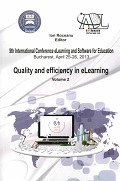PLAYFUL METHODS FOR EVALUATION, CORRECTION AND REHABILITATION OF VISUAL FUNCTION
PLAYFUL METHODS FOR EVALUATION, CORRECTION AND REHABILITATION OF VISUAL FUNCTION
Author(s): Mihaela Ioana Baritz, Diana Laura CotorosSubject(s): Education
Published by: Carol I National Defence University Publishing House
Keywords: games; visual function; optometry
Summary/Abstract: Some aspects concerning different forms of ”games” used to evaluate, correct and rehabilitate visual functions in optometric field are presented in this paper. In the first part of the paper some theoretical and experimental considerations about the eye movements, amblyopic or cross eyes manifested in preschool children and the importance of preserving the health of visual function during the life are presented. For this purpose, the paper presents some types of tests and devices designed to be used in evaluation, correction and rehabilitation of visual function of pre-school children. In the first part of the paper the visual anomalies discovered in pre-school children are presented, which should be carefully, constantly and competently analyzed and corrected in a personalized manner. Playful methods, based upon games perception or on the relaxed approach during the tests proved to be very helpful in that which means evaluation and correction methods. In the second part of the paper, we present a series of games and tests combinations, which stimulate besides the understanding ability also some functions of the visual system of the pre-school child, such as: in depth perception, threedimensional sight, eye movements, color vision, tracing contours. In the third part the authors present the evaluation and correction procedures for different cases, all based upon game method, effective and affective participation of the child and the visual function reactions and responses are observed together with the understanding development and participation to rehabilitation forms. These methods for stimulation and developing visual function can help specialists from optometric field to understand, to analyze different forms of visual behavior and to develop personalized evaluation procedures, correction and adaptation of visual impairments for children. Also the results, conclusions and future applications of these researches are presented.
Journal: Conference proceedings of »eLearning and Software for Education« (eLSE)
- Issue Year: 9/2013
- Issue No: 02
- Page Range: 127-132
- Page Count: 6
- Language: English

